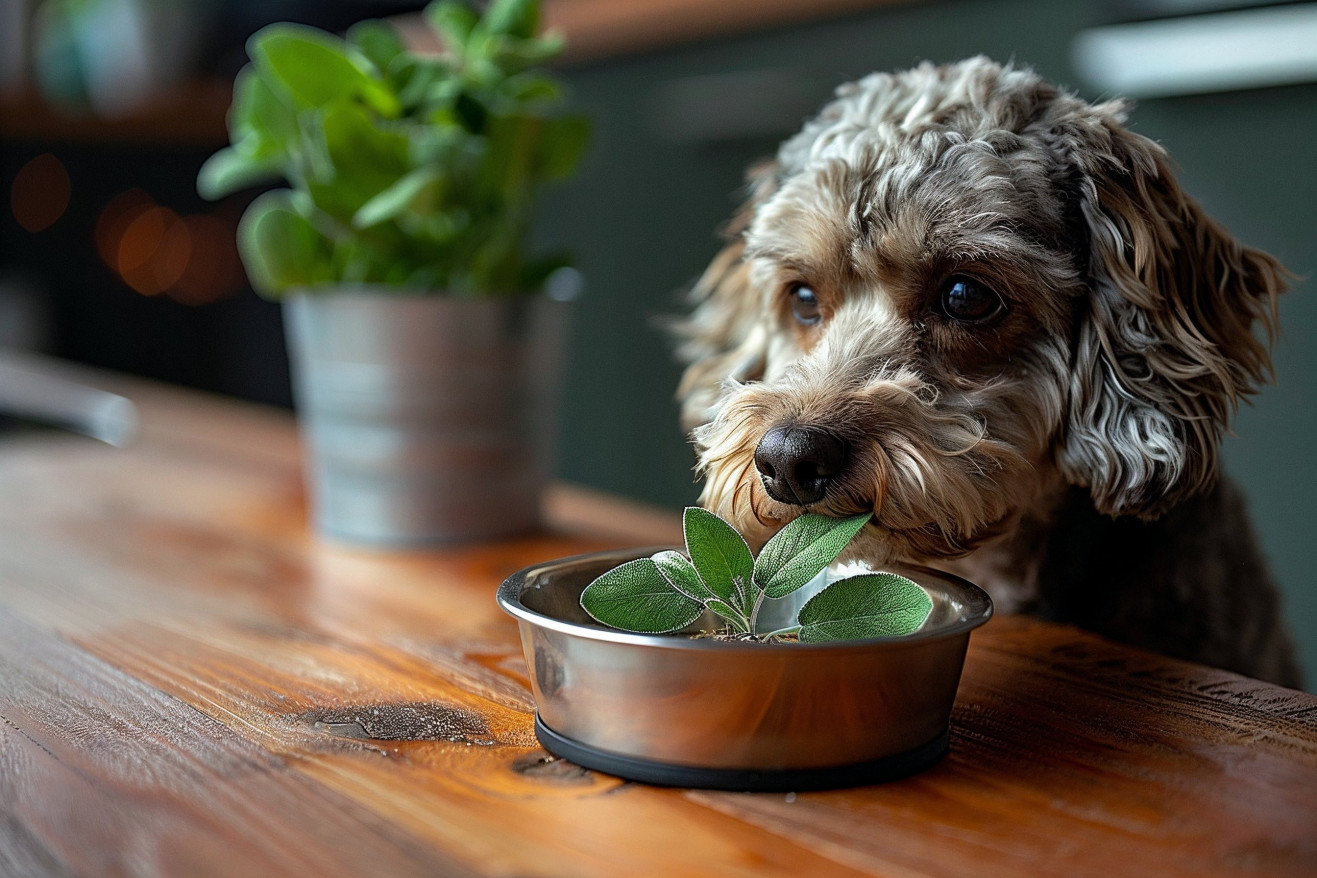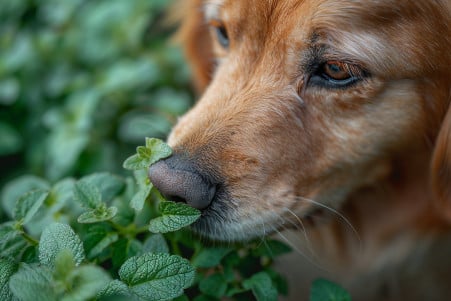Can Dogs Eat Sage? What to Know About Sage and Dogs
15 March 2024 • Updated 13 March 2024

Sage is a popular plant in many gardens, but is it OK for your dog to eat? In general, sage is safe for dogs in small amounts and can even provide some vitamins and antioxidants. However, it can be toxic in large amounts or if it’s in the form of an essential oil.
It’s important to introduce sage to your dog slowly and to talk to your vet about the right amount to give them.
To help you understand the ins and outs of how sage can affect your dog, we’ll look at veterinary toxicology, dog nutrition, and herbalism.
This article will bring together information from research on plant toxicity in animals, recommendations from professional veterinary organizations, and holistic veterinary medicine. Our aim is to give you a complete picture of how sage may impact your dog’s well-being, so you can decide whether or not to add it to your dog’s diet.
Can dogs eat sage?
Veterinary Toxicology and Canine Diets
Veterinary toxicology is an important discipline that helps us learn more about the impact of different substances on animal health. According to the Merck Veterinary Manual, veterinary toxicologists identify and characterize toxins, determine their fate in the body, and treat toxicosis.
This is important to note when it comes to introducing plants like sage into a dog’s diet, as the toxicological implications can be very different depending on the dosage and the dog’s metabolism.
All toxic reactions in dogs are dose-dependent, which means that the reaction will be more or less severe based on the amount of the substance that the dog ingests in relation to their body weight.
The LD50, or the dose lethal to 50% of a test sample, is a standard way to measure the safety of a substance, including herbs like sage. It’s a measure of a substance’s strength, letting us know how risky it is to consume.
When it comes to introducing new foods like sage to your dog, it’s important to make sure that you follow some general rules. Make sure that you start with small amounts and watch how your dog responds. Also, make sure that you don’t overdo it. While sage can be helpful, it’s important to make sure that you’re only giving your dog an amount that falls within the safe range.
Nutritional Value of Sage for Dogs
Sage is a nutrient-dense culinary herb that can provide several nutritional advantages for dogs. According to The Farmer’s Dog, sage is a good source of vitamins A, E, and K, which are important for bone, skin, and eye health and a strong immune system. It is also rich in minerals like calcium, magnesium, potassium, phosphorus, and zinc, which are all important for a dog’s overall nutrition.
In addition to its vitamins and minerals, sage is known for its high levels of antioxidants. According to DogTime, these antioxidants can help protect against oxidative stress and free radical damage, which may help lower the risk of chronic conditions and promote better health.
That said, sage also contains a substance called thujone, which can be toxic in high amounts.
As a result, while the ASPCA lists sage as safe and non-toxic for dogs, according to Yumwoof, it can lead to an upset stomach and diarrhea if consumed in large quantities.
To avoid this, make sure to feed your dog no more than a few fresh leaves or a small amount of dried sage in their food once or twice a week, and always consult your vet for personalized advice. This way, you can ensure your dog gets the benefits of sage without the risks.
Balancing the Pros and Cons of Herbs in Your Dog’s Diet
If you’re thinking about adding herbs to your dog’s diet, sage is just one of many options. While many herbs can be beneficial to dogs, it’s important to be cautious.
For example, Volhard Dog Nutrition notes that sweet basil, chamomile, and cinnamon can help with digestion, inflammation, and anxiety. However, they also note that a canine nutritionist should be consulted before adding these herbs to your dog’s diet because dogs have different taste receptors and nutritional needs.
Betterpet also notes that it’s important to do your research and talk to your vet before adding herbs to your dog’s diet. For example, parsley can help freshen breath and support organ function, but garlic and cocoa powder are both poisonous to dogs and should be avoided at all costs.
In addition, some herbs can interact with common dog medications, which can change their effectiveness or cause other problems. Preventive Vet also notes that it’s important to talk to your vet, especially if your dog is on medication, because many supplements can contain hidden ingredients that can be dangerous to pets.
When you look at sage in comparison to other herbs, it’s clear that while it can be good for dogs, it should be added to their diet with care, just like other herbs. By understanding the larger world of dog-safe herbs, you can make better decisions about whether or not to add sage and other similar ingredients to your dog’s diet.
How Dogs Metabolize Herbs: The Example of Sage
Knowing how dogs metabolize herbs like sage is important for understanding how safe it is for dogs to consume these natural substances. Dogs have different metabolic pathways than humans, which can impact the safety and efficacy of herbs when they are part of a dog’s diet.
According to The Merck Veterinary Manual, some of the ways in which dogs’ metabolic pathways may differ from humans’ include differences in liver enzymes, which can impact how fast a substance is metabolized and enters the bloodstream.
This difference in metabolism is important because it impacts the potential for toxicity. For example, dogs need to be able to metabolize thujone, a compound found in sage, in order to prevent it from building up in their bodies and causing toxic effects.
In a review of the literature on veterinary herbal medicine, Dr. Narda G. Robinson notes that understanding how herbs are metabolized in dogs is important because the difference between a therapeutic dose and a toxic dose is often quite small.
In order to make sure that sage can be used in a dog’s diet safely, it’s important to consider these metabolic differences. The American Holistic Veterinary Medical Foundation recommends that people who want to use sage in their dog’s diet start with small amounts and monitor their dog’s response to the herb, noting that herbs can interact with medications.
Understanding the details of how dogs metabolize herbs is important for dog owners who want to make sure that they can safely add sage to their pet’s diet.
Sage Advice: How to Add This Herb to Your Dog’s Diet
Adding sage to your dog’s diet may help them in a number of ways. You can start by adding a small amount of dried sage to their food, or even making sage tea and adding it to their water, as Spoiled Hounds recommends.
Just make sure to keep the amount small, adding only a pinch of dried sage or one to two fresh leaves. Also, make sure to introduce new foods slowly to ensure that your dog doesn’t have any adverse reactions, including stomach upset.
Make sure to watch your dog closely after they eat sage to see if they exhibit any signs of distress, changes in appetite, or other unusual behaviors. If you notice any of these signs, stop giving them the sage immediately and talk to your vet.
Always talk to your vet before adding anything new to your dog’s diet, especially if they have any underlying health issues. The Pet Beastro also recommends that you be careful with sage and pets that have epilepsy, as it contains active compounds that may trigger seizures.
If you want to make homemade dog treats, you can add sage to dog biscuits or a homemade meal. Just make sure that all of the other ingredients are safe for dogs and avoid adding sage to things like dressing or sausage, which may contain toxic ingredients like onion or garlic.
By following these tips, you can make sure that you’re adding the health benefits of sage to your dog’s diet in a safe way.
Conclusion: Sage and Your Dog’s Health
In summary, sage can be a healthy and beneficial addition to your dog’s diet in moderation. Full of vitamins and antioxidants, it can help your dog in a number of ways that can improve their health.
However, it’s important to make sure you’re introducing it safely and determining the right amount to give your dog. Too much sage, especially sage essential oil or large quantities of the herb, can be dangerous due to the thujone it contains.
Make sure to work with your vet to introduce new foods like sage. They can give you personalized advice based on your dog’s health and medical history, which is especially important to consider when it comes to potential drug interactions.
While herbs can play a role in a well-rounded dog diet, it’s important to remember that they shouldn’t replace the basics of a healthy diet. As a dog owner, it’s up to you to make careful and well-researched decisions about what you feed your dog. This way, you can make sure that your dog is healthy, happy, and well-fed.


